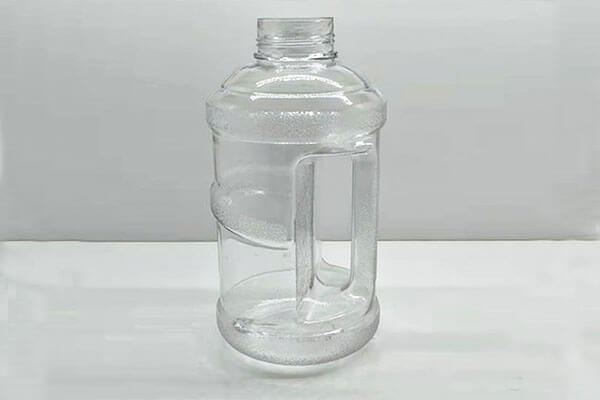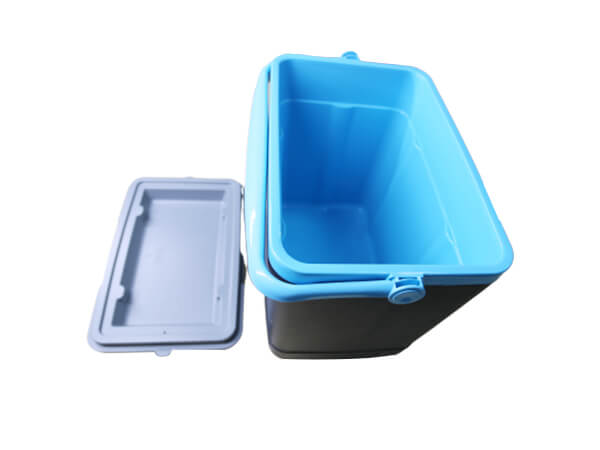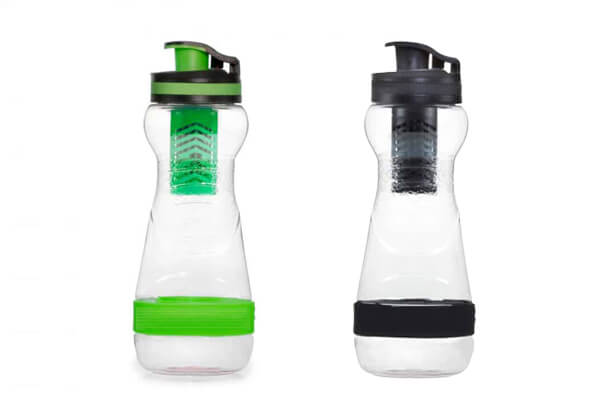Injection Blow Molding: Blow Moulding Products Manufacturing
Sungplastic will introduce more information regarding our injection blow molding capabilities for creating blow moulding products to provide further solutions to help your important projects.

What is Injection Blow Molding
Injection blow molding (IBM) is a manufacturing process used to produce hollow plastic objects, typically bottles or containers, with complex shapes and precise dimensions. It is a combination of two primary processes: injection molding and blow molding.
The injection blow molding process starts with the injection molding phase. In this phase, a molten plastic material, usually thermoplastic such as polyethylene (PE) or polypropylene (PP), is injected into a mold cavity to form a preform. The mold cavity has the shape of the desired final product, but it is in a smaller size.
Once the preform is formed, it is transferred to the blow molding phase. The preform is placed in a blow mold, which is typically a two-part mold consisting of a cavity and a core. The preform is clamped between the mold halves, and pressurized air is introduced into the cavity to expand the preform and conform it to the shape of the mold. The air pressure pushes the molten plastic against the mold walls, where it solidifies and takes the desired shape.
After the plastic has cooled and solidified, the mold is opened, and the finished hollow plastic object is ejected. The excess plastic material, known as flash, is trimmed off, resulting in a clean and finished product.
IBM process attributes including: no scrap, few trimming, no waste, not much auxiliary equipment required.

Blow Molding Processes
Blow molding stands as a key manufacturing process that shapes hollow plastic parts. Different blow molding processes are often used for different product production requirements. This technique encompasses the distinct processes for crafting blow molded pieces as below.
Injection Blow Molding
In the injection blow molding process, material is first injection molded. The heated material, still attached to the core pin, is subsequently moved to the blow molding station. Here, it is inflated into a bottle shape and allowed to cool. After cooling, the bottle progresses to the next station and is released. Injection blow molding affords finer intricacies in the neck and finish (threaded) area compared to extrusion blow molding. However, the process doesn’t yield significant enhancements in physical properties, as minimal orientation takes place.
Stretch Blow Molding
This blow molding variant gives rise to hollow articles, such as bottles, with a biaxial molecular orientation. This orientation augments physical attributes, transparency, and resistance to gas permeation—a critical factor in items like carbonated beverage bottles.
There are two key modes of stretch blow molding:
In the one-stage process, preforms undergo injection molding, are conditioned to optimal temperature, and are immediately transformed into containers, all within a continuous operation. This approach excels in niche applications, such as wide-mouthed jars, where exceedingly high production speeds aren’t imperative.
The two-stage process involves injection molding of preforms, followed by a brief storage period (typically 1 to 4 days), culminating in the use of a reheat-blow (RHB) machine to shape containers. Given the relatively higher costs of molding and RHB equipment, this technique becomes optimal for manufacturing high-volume goods like carbonated beverage bottles.
Reheat and Blow Molding
Reheat and blow molding is a manufacturing process used to produce hollow plastic containers, primarily bottles, jars, and containers with high clarity and strength. It is a variation of the blow molding process that involves two distinct stages: preform production and bottle formation.
The process begins with the production of preforms. Preforms are small, tubular-shaped plastic pieces with a threaded neck finish. They are typically made through injection molding, where molten plastic material, such as polyethylene terephthalate (PET), is injected into a mold cavity to form a partially shaped preform. The mold has the shape of the desired bottle, but it is in a smaller size and lacks the final hollow shape.
Once the preforms are produced, they are cooled and removed from the injection molds. These preforms are then fed into a reheat stretch blow molding machine for the second stage of the process.
In the reheat stage, the preforms are heated to a specific temperature, typically above their glass transition temperature, to make them flexible for stretching. This heating is accomplished using infrared heaters or other heating methods. The heated preforms are then transferred to the blow molding station.
In the blow molding stage, the heated preforms are clamped in a mold with a cavity that has the shape of the final bottle. A stretch rod is inserted into the preform, and pressurized air is blown into it. The combination of the stretch rod and the air pressure stretches the softened preform while blowing it against the mold walls. As a result, the preform takes the shape of the mold cavity and solidifies into the final bottle shape.
After the blowing process, the mold is opened, and the newly formed bottles are ejected. Excess material, known as flash, is trimmed off, and the bottles undergo any necessary additional processes, such as neck finishing or labeling, before they are ready for packaging.
Reheat and blow molding offers several advantages, including the ability to produce bottles with high clarity, strength, and precise neck finishes. It is commonly used for the production of PET bottles for beverages, personal care products, household cleaners, and other liquid products.
Compression Blow Molding
Compression blow molding is a manufacturing process used to produce hollow plastic parts, such as bottles and containers. It is a combination of compression molding and blow molding techniques.
The compression blow molding process involves the following steps:
- Preform Creation:
Initially, a plastic preform is created by injection molding or extrusion. The preform is a solid piece of plastic with a shape similar to the desired final product. The preform is typically larger and thicker than the final product. - Preform Transfer:
The preform is transferred to a blow molding machine, where it is clamped into a mold. - Compression:
The mold closes, and the preform is compressed between the two halves of the mold using hydraulic pressure. This compression ensures that the plastic material fills the mold completely and uniformly. - Heating:
Once the preform is compressed, it is heated using infrared heaters or other heating methods. The heat softens the plastic, making it malleable and ready for the blow molding process. - Blow Molding:
After reaching the desired temperature, the mold is opened slightly, and compressed air is injected into the preform. The air expands the softened plastic, forcing it to take the shape of the mold cavity. - Cooling and Ejection:
The mold is then cooled to solidify the plastic in the desired shape. Once cooled, the mold opens, and the finished product is ejected.
Compression blow molding offers several advantages over other molding processes. It allows for the production of complex shapes with high accuracy and excellent surface finish. The process is also suitable for various materials, including high-density polyethylene (HDPE), polyethylene terephthalate (PET), and polypropylene (PP). Additionally, compression blow molding is a cost-effective method for mass production because it allows for faster cycle times and reduced material waste.
This process is commonly used in the production of bottles, containers, and other hollow plastic products that require high-quality finishes and precise dimensions.
Extrusion Blow Molding
Initiating the extrusion blow molding procedure involves the initial extrusion of a parison or tube through a die, similar to those employed in plastic pipe fabrication. The parison is then downwardly extruded between two halves of an open blow mold. Once the parison reaches the desired length, the mold closes, holding the neck end open while sealing the bottom end. A rod-like blow pin is introduced into the neck end of the heated parison. This serves the dual purpose of forming the threaded opening and inflating the parison within the mold cavity. Following the cooling of the bottle, the mold opens, expelling the finished product. Superfluous plastic is trimmed from the neck and bottom pinch-off regions. However, there is typically a high level of scrap produced.
Advantages of Injection Blow Molding
Injection blow molding offers several advantages compared to other manufacturing processes for producing hollow plastic objects. Here are some of the key advantages of injection blow molding:
- Precise and Complex Shapes:
Injection blow molding allows for the production of hollow plastic objects with intricate and precise shapes. The process enables the creation of complex geometries, including contoured surfaces, handles, and other unique features, which may be difficult to achieve with other molding methods. - Uniform Wall Thickness:
Injection blow molding ensures uniform wall thickness in the final product, resulting in consistent strength and structural integrity. This uniformity is crucial for applications that require balanced distribution of material, such as containers that need to withstand internal pressure. - Reduced Material Waste:
The injection blow molding process minimizes material waste. The mold cavity is designed to produce preforms that closely resemble the final product’s shape, reducing the amount of excess material that needs to be trimmed off during the finishing process. This leads to cost savings and a more sustainable manufacturing approach. - Enhanced Surface Finish:
Injection blow molding can produce plastic objects with excellent surface finish quality. The mold cavity’s smooth surfaces transfer onto the final product, resulting in a polished and aesthetically appealing appearance. This is particularly important for applications where visual appeal is a key factor, such as consumer packaging. - Efficient Production:
Injection blow molding is a relatively fast and efficient process, allowing for high production volumes. The use of automated machinery and continuous production cycles facilitates a streamlined manufacturing process, reducing production time and labor costs. - Compatibility with Various Materials:
Injection blow molding is compatible with a wide range of thermoplastic materials, including polyethylene (PE), polypropylene (PP), polyethylene terephthalate (PET), and more. This versatility allows manufacturers to select the most suitable material based on the specific requirements of the end product. - Cost-Effective Tooling:
The tooling costs for injection blow molding are often lower compared to other molding techniques. Since the process involves a smaller mold cavity for the preform and a blow mold for the final shape, the overall tooling costs can be more economical, especially for smaller and medium-sized production runs.
Injection Blow Molding Applications
Injection blow molding is widely used in various industries for the production of hollow plastic objects. Here are some specific applications where injection blow molding is commonly employed:
- Packaging Industry:
Injection blow molding is extensively utilized in the packaging industry to manufacture bottles, containers, and jars. These containers find applications in sectors such as food and beverage, personal care, household chemicals, pharmaceuticals, and more. Injection blow molding enables the production of containers with precise dimensions, uniform wall thickness, and attractive designs. The process is particularly suitable for producing small to medium-sized bottles, including those with complex shapes, handles, or special features. - Pharmaceuticals:
Injection blow molding is widely employed in the pharmaceutical industry for the production of plastic containers used for packaging medications, vitamins, and other healthcare products. The process ensures the containers meet stringent quality and hygiene standards. The containers can be designed with child-resistant closures, tamper-evident features, and specific dosing mechanisms. - Cosmetics and Personal Care:
Injection blow molding is used to produce plastic containers for various cosmetic and personal care products such as shampoos, lotions, creams, and perfumes. The process allows for the creation of containers with aesthetically pleasing designs and precise neck finishes suitable for pumps, sprayers, and other dispensing mechanisms. - Automotive Industry:
Injection blow molding is employed in the automotive industry to manufacture components such as reservoirs, fluid containers, and ducts. These components require precise dimensions, durability, and resistance to chemicals and temperature variations. Injection blow molding allows for the production of automotive parts with high accuracy and excellent performance characteristics. - Laboratory and Medical Equipment:
Injection blow molding is utilized to produce laboratory equipment, medical devices, and diagnostic tools. These include test tubes, vials, sample containers, and various other items used in research, analysis, and healthcare settings. Injection blow molding ensures the production of containers with excellent clarity, chemical resistance, and sterile properties. - Industrial Containers:
Injection blow molding is employed to manufacture industrial containers such as drums, canisters, and tanks. These containers are used for storage, transportation, and handling of various liquids, chemicals, and industrial products. Injection blow molding enables the production of containers with high strength, durability, and resistance to harsh environmental conditions. - Sports and Recreation:
Injection blow molding is utilized for the production of sports and recreation products such as water bottles, sports bottles, and inflatable equipment. These products require lightweight yet durable construction, precise dimensions, and resistance to impact and deformation.
Injection Blow Molding Materials
Injection blow molding is a manufacturing process used to produce hollow plastic objects by inflating a heated plastic material into a mold cavity. Various types of materials can be used in injection blow molding, each offering unique properties and characteristics. Here is an introduction to some commonly used blow molding materials:
- Polyethylene (PE):
Polyethylene is one of the most widely used materials in blow molding. It is a thermoplastic polymer with excellent toughness, flexibility, and chemical resistance. High-density polyethylene (HDPE) and low-density polyethylene (LDPE) are commonly used in blow molding applications. HDPE is known for its stiffness and strength, making it suitable for containers that require rigidity. LDPE, on the other hand, offers greater flexibility and is often used for squeeze bottles and containers that require good impact resistance. - Polypropylene (PP):
Polypropylene is another popular material used in blow molding. It is a versatile thermoplastic with good chemical resistance, impact strength, and high melting point. PP is commonly used for producing bottles, containers, and automotive components. It offers a balance of stiffness and toughness, making it suitable for a wide range of applications. - Polyethylene Terephthalate (PET):
PET is a transparent and lightweight material widely used for blow molding applications, particularly in the production of beverage bottles. It offers excellent clarity, chemical resistance, and barrier properties to oxygen and carbon dioxide. PET bottles are highly recyclable and have become the standard choice for carbonated drinks, water, and other beverages. - Polyvinyl Chloride (PVC):
PVC is a versatile plastic material used in various applications, including blow molding. It offers good chemical resistance, durability, and flame retardant properties. PVC is commonly used for producing bottles, containers, and rigid packaging. - Polyethylene Naphthalate (PEN):
PEN is a high-performance thermoplastic material used in blow molding for applications that require excellent barrier properties. It has superior resistance to gas permeation, making it suitable for packaging products such as carbonated beverages, edible oils, and other sensitive contents. - Polycarbonate (PC):
Polycarbonate is a strong and impact-resistant material used in plastic blow molding for applications that require exceptional clarity and durability. It is commonly used for producing water bottles, baby bottles, and other products that require transparency and toughness. - Polyamide (PA):
Polyamide, commonly known as nylon, is used in plastic blow molding for applications where strength, chemical resistance, and dimensional stability are important. It is often used for producing fuel tanks, automotive components, and industrial containers.
The choice of material depends on the specific requirements of the end product, including properties such as strength, flexibility, clarity, chemical resistance, and barrier properties.
Injection Blow Molding vs Extrusion Blow Molding
Injection Blow Molding and Extrusion Blow Molding are both prominent techniques in plastic manufacturing, but they exhibit notable distinctions in various aspects:
- Type of Products
Injection blow molding is commonly used for producing small, intricate, and often highly detailed products such as small bottles, medical containers, and pharmaceutical vials.Extrusion blow molding is typically employed for larger, hollow objects with simple shapes, like larger bottles, containers, drums, and automotive components.
- Molds
Injection blow molding utilizes a combination mold that integrates injection molding and blow molding components, which allows for more precise detailing in the neck and finish areas.Extrusion blow molding involves a simpler, split mold that opens and closes around the parison. It is generally more straightforward and less intricate compared to the mold used in injection blow molding.
- Types of Materials
Injection blow molding is well-suited for a broader range of materials, including thermoplastics and materials requiring higher precision, like PET (polyethylene terephthalate).Extrusion blow molding is typically used with materials that have good melt strength, like HDPE (high-density polyethylene) and PP (polypropylene).
- Complexity and Detail
Injection blow molding offers higher precision and intricate detailing due to the integrated injection molding step. This makes it suitable for products with fine threads, thin walls, and complex features.Extrusion blow molding typically produces products with simpler shapes and less detailed features.
- Material Orientation
Injection blow molding provides limited orientation of the material molecules, resulting in relatively modest improvements in physical properties.Extrusion blow molding offers greater molecular orientation, which can contribute to enhanced mechanical properties.
- Production Speed and Volume
Injection blow molding is well-suited for lower to moderate production volumes due to the integrated injection molding step and slightly more complex process.Extrusion blow molding is suited for higher production volumes due to its efficient and continuous nature.
- Cost Considerations
Injection blow molding generally involves higher tooling and equipment costs due to the combined nature of injection molding and blow molding processes.Extrusion blow molding tends to have lower tooling and equipment costs, making it more economical for high-volume production.
- Applications
Injection blow molding is used in industries requiring precise details and moderate production volumes, such as pharmaceuticals, cosmetics, and specialized packaging.Extrusion blow molding is found in industries demanding higher production rates and larger, simpler plastic products, such as consumer goods, industrial packaging, and automotive components.
- Flexibility and Changeovers
Injection blow molding allows for quicker changeovers and adjustments for different product designs and sizes.Extrusion blow molding may require more time for mold changes and adjustments, making it less suitable for frequent design changes.

Blow Molding vs Injection Molding
Blow molding and injection molding are distinct plastic manufacturing processes. Blow molding focuses on hollow objects, using a molten plastic parison inflated within a mold to create items like bottles and containers. In contrast, injection molding involves injecting molten plastic into a mold under high pressure, yielding a wide range of products, from intricate components to larger parts. Blow molding is ideal for simple hollow shapes, while injection molding excels in detailed and complex designs. While blow molding offers lower tooling costs and is suitable for moderate to high volumes, injection molding is versatile, catering to high-volume production with precise detailing and a broader material range. Blow molding typically uses simpler molds, often split molds, which encase the parison or preform during the blowing process.
Injection molding’ s molds can be more complex, incorporating intricate core and cavity designs for creating detailed parts.
PET Blow Moulding: Solutions for Plastic Bottle Making
PET, or polyethylene terephthalate, is a widely used thermoplastic polymer in the plastics industry. Known for its versatility and various desirable properties, PET finds applications in diverse sectors. It is commonly used in packaging, particularly for food and beverages, due to its clarity, lightweight nature, and excellent barrier properties against moisture and gases. PET is often employed in the production of bottles, containers, and packaging films for products such as water, soft drinks, juices, and condiments. It can be processed through techniques like injection molding and plastic blow molding to create a range of products, from intricate components to hollow containers. Additionally, PET’s recyclability makes it a preferred choice in sustainable packaging efforts.
PET blow moulding is a manufacturing process used to produce hollow plastic parts, typically for plastic bottle making or containers manufacturing, made from PET (polyethylene terephthalate) plastic. In this process, a preform – a tube of PET material with a specific shape – is heated and then inflated to form the final shape of the bottle.
PET blow moulding Process including:
- Injection molding:
A preform is created by injecting molten PET material into a mold cavity. - Conditioning:
The preform is heated to a specific temperature to make it malleable and ready for the blow molding process. - Stretch blow molding:
The preform is placed into a plastic blow molding machine, where it is stretched and blown into its final shape using compressed air.
Sungplastic Injection Blow Molding Services
Opting for injection blow molding as the avenue to materialize your product offers a highly advantageous approach, particularly when aiming to achieve large-scale production of straightforward yet impactful designs, all while maintaining budgetary considerations. As an injection molding manufacturer with many years of production experience, we also offer our customers additional blow molding services. We have a stable blow molding manufacturing partner to save supply chain management costs and provide a more convenient product manufacturing process for customers. Our team is made up of highly skilled and business-savvy experts who can seamlessly guide the evolution of your product from mere concept to tangible reality. Essentially, our collaboration covers the entire spectrum of the design and production phases, ensuring the end result is something you can be proud of.
With an unwavering commitment to your project’s success, Sungplastic invites you to reach out to us without delay.
FAQs about Injection Blow Molding
- Q: Can different colors be easily achieved in injection blow molding?
Yes, injection blow molding can accommodate a variety of colors by adding colorants or masterbatches to the molten plastic material before injection. - Q: Is injection blow molding suitable for prototyping and small production runs?
While injection blow molding is more commonly associated with larger production volumes, some manufacturers offer options for prototyping and small runs, although other processes like rapid prototyping or 3D printing may be more cost-effective for very low quantities. - Q: Is it possible to incorporate multi-layer structures using injection blow molding?
Yes, injection blow molding can accommodate multi-layer structures, enabling enhanced barrier properties, UV protection, or other specialized functions within the final product.
About Sungplastic
Sungplastic is a plastic product manufacturer with rich experience in injection molding. According to the different product development requirements, we flexibly adjust the manufacturing process to achieve high quality, high efficiency and more economical.
We offer a variety of manufacturing services: Rapid Prototyping, Tool Making, Injection Molding, Product Design and Development, CNC Machining and Metal Stamping. You can choose from a variety of plastics, silicone rubber, or metal for your product. Regardless of mass production or small batch customization, Sungplastic has always been committed to providing assured, efficient and more economical one-stop processing services for your projects.
Contact us for a free quote and project review.
Get a free quote and design analysis today.
We’ll reply you within 6 working hours.
We respect your privacy.
+86 139 2927 4777 (WhatsApp, Wechat)



